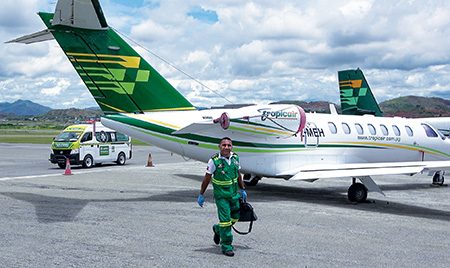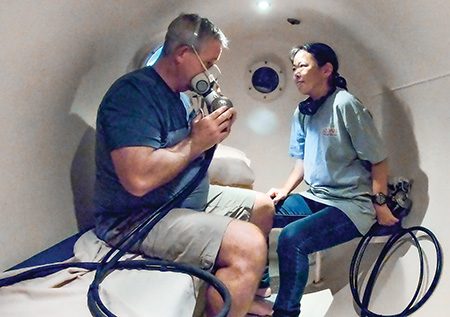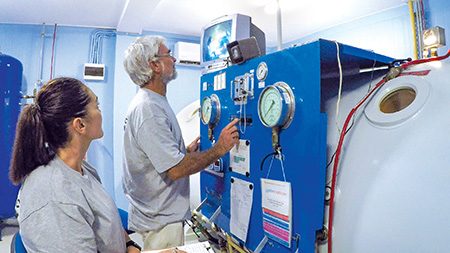Estaba buceando con mi esposa, Kristy Hiltz, en la remota Kimbe Bay, Papúa Nueva Guinea. Habíamos tomado todas las precauciones necesarias y habíamos buceado según las indicaciones de nuestras computadoras. En lo que resultó ser nuestro último buceo, nos sentamos sobre una saliente de roca a 21 metros (70 pies) por 15 a 20 minutos y luego hicimos un ascenso lento y realizamos una parada de seguridad completa. Mientras subía a la embarcación supe que algo estaba mal, pero pensé que tenía que beber agua y esperar a que pasara.
Mi visión se volvió borrosa, me dolía el estómago, estaba mareado y tenía problemas para hablar con claridad. Afortunadamente, mi esposa es una veterinaria con suficientes conocimientos de medicina para percibir que tenía una enfermedad por descompresión (EDC). Solicitó oxígeno y yo me acosté y me concentré en respirarlo e intentar no desmayarme. Siempre adquirimos una cobertura de DAN, pero nunca esperamos necesitarla. De repente, fuimos conscientes de lo acertado que era tenerla.
Kristy y el director de tour alertaron al capitán y conversaron sobre DAN y la evacuación médica. Podía oír las llamadas telefónicas y las palabras “grave” y “síntomas neurológicos”. El capitán se comunicó con la línea de emergencias de DAN y los miembros del personal médico de DAN planificaron el camino más rápido hasta el centro de atención médica más cercano, que se encontraba en Puerto Moresby.
Intenté respirar sin oxígeno, pero sentí náuseas, mareos y confusión de inmediato. Estábamos a varias horas de la costa, y la experiencia se estaba volviendo muy aterradora. Llegamos tarde por la noche, por lo que permanecí en la embarcación con oxígeno hasta el amanecer, cuando una ambulancia llegó a buscarme. Era una vieja furgoneta con un colchón gastado y herramientas en la parte trasera, pero estaba agradecido por los conductores y el oxígeno que recibí durante el viaje de dos horas hasta el aeropuerto.
Un avión nos estaba esperando en la pista, y rápidamente Kristy y yo estábamos en el aire. Una vez a bordo me dieron medicación contra las náuseas, fluidos por vía intravenosa, más oxígeno y un cómodo catre, y la cabina estaba presurizada para simular el entorno al nivel del mar. Mientras volábamos a Puerto Moresby, sabía lo que estaba sucediendo, pero las náuseas y los mareos eran muy molestos.
La cámara hiperbárica estaba en el aeropuerto, así que el piloto acercó el avión al edificio, que en su interior estaba impecable y era impresionante. El equipo estaba listo e inmediatamente me llevaron a la cámara para una sesión de seis horas. Pronto sentí que mis síntomas disminuían por primera vez desde el buceo. Finalmente podía pensar con claridad y no sentía ganas de vomitar.

Después del tratamiento en cámara me sentía completamente bien y todos mis síntomas habían desaparecido. El médico me prohibió volar por cuatro días, por lo que permanecí en un hotel cercano para ser controlado y evaluado diariamente hasta que pudiera irme a casa. El médico me explicó que la EDC es peligrosa y que casi había experimentado una catástrofe. También me recordó que volar a casa sin completar un tratamiento en cámara hiperbárica apropiado suponía un riesgo potencialmente mortal.
Nuestra cobertura contra accidentes de buceo de DAN cubrió los gastos médicos, de hotel y de comidas —con el costo astronómico del tratamiento de evacuación que había recibido, sabía que éramos afortunados de tenerla—. Un avión privado u otra forma de evacuación desde un área remota puede tener un costo superior a los USD 100.000 solo por el traslado y requiere un pago garantizado antes de la evacuación. El costo podría haber demorado el tratamiento o llevado a tomar decisiones más riesgosas. Pero con la cobertura de DAN, pudimos concentrarnos en lo que necesitábamos en lugar de lo que podíamos afrontar.
Más tarde vi a un cardiólogo experto en medicina de buceo que me examinó exhaustivamente y leyó mi registro de buceo y los informes del médico. Me dijo que era muy afortunado de haber sobrevivido y que la pérdida de visión es una indicación de peligro de daño neurológico. Tuve la suerte de que hubiera una cámara disponible. El cardiólogo también dijo que casi todos los buzos que experimentan una EDC dependen de una computadora de buceo sin comprender sus limitaciones.


Desde entonces, me he enterado de que me encuentro entre el 27 por ciento de las personas que tienen un foramen oval permeable —un orificio entre los lados derecho e izquierdo del corazón, que está relacionado con un mayor riesgo de EDC—. Los buzos a menudo no están al tanto de que tienen uno. Depender en gran medida de mi computadora de buceo para calcular el tiempo de fondo fue riesgoso, y si bien estaba buceando de acuerdo con la capacitación que había recibido, un enfoque más conservador podría ayudar a evitar más incidentes.
No puedo imaginar bucear en algún lugar sin la cobertura de DAN. Al planificar viajes de buceo a lugares remotos hemos empezado a comprobar las ubicaciones de las cámaras. Valoramos que nuestra cobertura nos ayuda en caso de emergencia y contribuye a financiar las cámaras y los equipos que brindan atención para salvar las vidas de buzos de todo el mundo.
En el momento en que necesitamos ayuda, en DAN no podrían haber sido más serviciales. Siempre estaremos agradecidos por todo lo que hicieron por nosotros.
© Alert Diver — Q1 2024